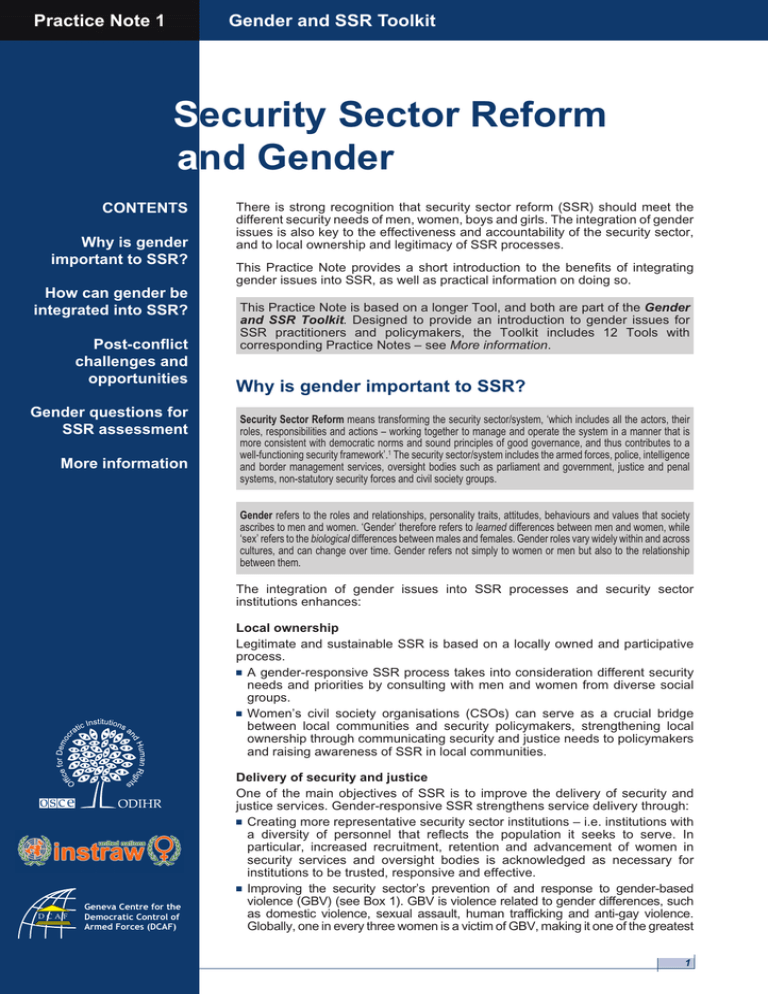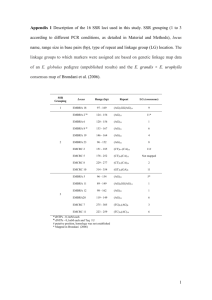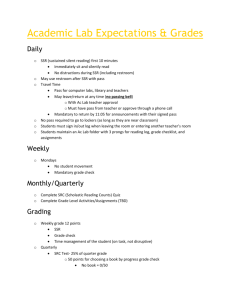
Practice Note 1
Gender and SSR Toolkit
Security Sector Reform
and Gender
CONTENTS
Why is gender
important to SSR?
How can gender be
integrated into SSR?
Post-conflict
challenges and
opportunities
Gender questions for
SSR assessment
More information
There is strong recognition that security sector reform (SSR) should meet the
different security needs of men, women, boys and girls. The integration of gender
issues is also key to the effectiveness and accountability of the security sector,
and to local ownership and legitimacy of SSR processes.
This Practice Note provides a short introduction to the benefits of integrating
gender issues into SSR, as well as practical information on doing so.
This Practice Note is based on a longer Tool, and both are part of the Gender
and SSR Toolkit. Designed to provide an introduction to gender issues for
SSR practitioners and policymakers, the Toolkit includes 12 Tools with
corresponding Practice Notes – see More information.
Why is gender important to SSR?
Security Sector Reform means transforming the security sector/system, ‘which includes all the actors, their
roles, responsibilities and actions – working together to manage and operate the system in a manner that is
more consistent with democratic norms and sound principles of good governance, and thus contributes to a
well-functioning security framework’.1 The security sector/system includes the armed forces, police, intelligence
and border management services, oversight bodies such as parliament and government, justice and penal
systems, non-statutory security forces and civil society groups.
Gender refers to the roles and relationships, personality traits, attitudes, behaviours and values that society
ascribes to men and women. ‘Gender’ therefore refers to learned differences between men and women, while
‘sex’ refers to the biological differences between males and females. Gender roles vary widely within and across
cultures, and can change over time. Gender refers not simply to women or men but also to the relationship
between them.
The integration of gender issues into SSR processes and security sector
institutions enhances:
Local ownership
Legitimate and sustainable SSR is based on a locally owned and participative
process.
■ A gender-responsive SSR process takes into consideration different security
needs and priorities by consulting with men and women from diverse social
groups.
■ Women’s civil society organisations (CSOs) can serve as a crucial bridge
between local communities and security policymakers, strengthening local
ownership through communicating security and justice needs to policymakers
and raising awareness of SSR in local communities.
DCAF
Geneva Centre for the
Democratic Control of
Armed Forces (DCAF)
Delivery of security and justice
One of the main objectives of SSR is to improve the delivery of security and
justice services. Gender-responsive SSR strengthens service delivery through:
■ Creating more representative security sector institutions – i.e. institutions with
a diversity of personnel that reflects the population it seeks to serve. In
particular, increased recruitment, retention and advancement of women in
security services and oversight bodies is acknowledged as necessary for
institutions to be trusted, responsive and effective.
■ Improving the security sector’s prevention of and response to gender-based
violence (GBV) (see Box 1). GBV is violence related to gender differences, such
as domestic violence, sexual assault, human trafficking and anti-gay violence.
Globally, one in every three women is a victim of GBV, making it one of the greatest
1
Box 1
Post-conflict justice mechanisms in Sierra Leone: effectively addressing crimes of
sexual violence 3
It is estimated that over 250,000 women were raped during Sierra Leone’s decade-long civil war. In the aftermath of the war, a combination of justice
mechanisms were employed, including the Special Court for Sierra Leone, a Truth and Reconciliation Commission and traditional justice mechanisms.
Many positive steps have been taken by the Special Court to seek to ensure that crimes of sexual violence are adequately addressed:
- Adopting a broad definition of sexual violence, including ‘rape, sexual slavery, enforced prostitution, forced pregnancy and any other form of sexual
violence’.
- Specifically tasking a trial attorney to develop a prosecution plan for sexual violence crimes.
- Assigning two experienced female investigators (out of a team of 10) to investigate crimes of sexual violence.
- Adopting a gender-sensitive interview method to ensure that victims feel comfortable reporting crimes.
- Emphasising witness preparation, to ensure that witnesses understand the implications of testifying.
Although it is too early to draw definite conclusions regarding the success of the Special Court’s handling of sexual violence, the first judgements of the
Court (delivered on 20 June 2007) included convictions for rape as a crime against humanity and sexual slavery.
■
threats to human security.2 Men and boys are also
victims of GBV, and may face even greater barriers
than women in reporting it and seeking justice.
Increasing collaboration between security sector
institutions and CSOs, including women’s groups.
CSOs can provide complementary security and
justice services, and help to build the capacity of
security sector institutions through training,
research and expert advice on gender issues.
Oversight and accountability of the security sector
A core objective of SSR is to reform security sector
institutions so that they are transparent; respectful of
the rule of law and human rights; and accountable to
democratic civilian authority, such as parliament and
the justice system. Gender-responsive SSR
strengthens oversight and accountability through:
■ The increased participation of women, gender
experts and women’s organisations in official
oversight bodies and processes (see Box 2).
■ Gender-responsive initiatives to prevent, respond
to and sanction human rights violations committed
by security sector personnel.
Compliance with obligations under international laws and
instruments
Taking the initiative to integrate gender issues into SSR is not only a
matter of operational effectiveness; it is also necessary to comply with
international and regional laws, instruments and norms concerning
security and gender. Key instruments include:
■ The Beijing Declaration and Platform for Action (1995)
■ United Nations Security Council Resolution 1325 on Women, Peace
and Security (2000)
For more information, please see the Toolkit’s Annex on International
and Regional Laws and Instruments.
How can gender be integrated into
SSR?
Two complementary strategies can be used to
integrate gender issues into SSR policy and
programming:
✔
2
Gender mainstreaming involves considering the
impact of all SSR policies and programmes on
women, men, boys and girls at every stage of the
policy and programme cycle, including assessment,
planning, implementation, monitoring and evaluation.
✔
!
Promoting equal participation of men and women: as
men are highly over-represented within SSR
processes and security institutions, action is required
to increase recruitment, retention and advancement
of women, and to ensure the participation of CSOs,
including women’s organisations.
Tips for gender-responsive SSR policy
Gender mainstreaming
✔ Involve gender experts – such as representatives
from women’s ministries, parliamentarians with
gender expertise and experts from CSOs – in
drafting SSR policy.
✔ Build the gender awareness and capacity of the
team(s) responsible for drafting, implementing and
evaluating SSR policy (e.g. through gender training
or briefings).
✔ Identify and mobilise ‘gender champions’ – i.e.
senior level decision-makers that support the
inclusion of gender issues.
✔ Conduct a gender impact assessment of the
proposed SSR policy, and monitor and evaluate the
policy’s impact on men, women, girls and boys.
Equal participation of men and women
✔ Ensure that SSR is grounded in a participatory
consultation process, including civil society
representatives from women’s and men’s
organisations.
Box 2
Women’s organisations’
participation in Fiji’s security and
defence review 4
In Fiji, women’s non-governmental organisations, working with the
Ministry of Women’s Affairs, provided input for the 2003 national security
and defence review process. They met with the Fijian Government’s
National Security and Defence Review Committee to discuss:
- How the review process was being conducted
- Who was being consulted
- Which issues were identified as security threats
- How international standards and norms, such as UN Security Council
Resolution 1325, were being incorporated into defence programming.
The women’s organisations made concrete recommendations, including
for the permanent appointment of the Minster for Women to the National
Security Council and representation of women on Divisional and District
Security Committees.
✔
!
Ensure representation of women and men in the
teams responsible for the assessment, drafting,
implementation, monitoring and evaluation of SSR
policies.
Tips for gender-responsive SSR
programme design
‘Understanding the role of women is important when
building stability in an area… If women are the daily
breadwinners and provide food and water for their
families, patrolling the areas where women work will
increase security and allow them to continue. This is
a tactical assessment… Creating conditions for a
functioning everyday life is vital from a security
perspective. It provides a basis for stability.’
Brigadier Karl Engelbrektson, Force Commander of
the Nordic Battlegroup 5
Gender issues should also be incorporated into the
framework for SSR programme design:
■
■
■
■
Objectives: Do the objectives include the improved
delivery of security and justice services to men,
women, girls and boys? More representative and
participative security sector institutions? Increased
accountability and reduced human rights violations?
Beneficiaries: Are the beneficiaries of SSR clearly
identified? Are women, girls and marginalised men
and boys included?
Activities: Are initiatives included to address the
particular security needs of women and girls, as
well as marginalised men and boys? Are there
activities to increase the participation of women and
other under-represented groups in security sector
institutions? What activities address human rights
violations by security sector personnel?
Outputs: Are specific outputs directed towards
women, men, girls and boys? Are there outputs that
focus on preventing, responding and prosecuting
GBV and increasing the recruitment, retention and
advancement of women within security and justice
institutions?
Box 3
■
■
■
Indicators: Are there specific indicators to monitor
gender-related objectives and the impact of gender
activities? Are indicators sex-disaggregated?
Budget: Are specific funds earmarked for gender
objectives, activities and outputs?
Partners: Are women’s and men’s organisations,
and organisations working on gender issues,
included as potential partners? Do identified partners
have the commitment and capacity to work in a
gender-responsive manner? Are responsibilities and
expectations regarding gender clearly spelled out in
programme documents, agreements and contracts?
Also available in Tool 1…
- Questions for a gender impact assessment of security policy
- Tips on integrating gender into SSR assessment, design,
implementation, monitoring and evaluation
- An assessment process for law enforcement agencies to increase
their recruitment and retention of women
- Examples of good practices from reform processes in Brazil, the
Democratic Republic of the Congo, Hungary, Sierra Leone, South
Africa, Sweden and the United Kingdom
Post-conflict challenges and
opportunities
In post-conflict environments, SSR is essential to
prevent the re-occurrence of conflict and to enhance
public security, which in turn is necessary to initiate
reconstruction and development activities. While
every context is unique, there are particular
challenges and opportunities for the integration of
gender issues into post-conflict SSR:
Challenges for the integration of gender issues
Disarmament, demobilisation and reintegration (DDR)
processes often fail to include women and girls.
■ Pressure to quickly build security sector institutions
may result in gender issues being insufficiently
prioritised in recruitment, training and logistics.
■ Lack of infrastructure and capacity can hinder
women’s access to justice.
■
Modernisation of the Nicaraguan police force 6
The modernisation of the National Police Force of Nicaragua demonstrates the benefits of initiatives to mainstream gender and increase the
participation of women. A broad range of gender reforms of the Nicaraguan police was initiated in the 1990s, following pressure from the
Nicaraguan women’s movement and from women within the police. As part of a project supported by the German development organisation (GTZ),
specific initiatives were undertaken including:
- Training on GBV within police academies
- Women’s police stations, providing a range of services to women and child victims of violence, in partnership with CSOs
- Reform of recruitment criteria including female-specific physical training and the adaptation of height and physical exercise requirements for
women
- Policies to allow police officers to combine jobs and family life
- Establishment of a Consejo Consultivo de Género as a forum for discussion and investigation into the working conditions of female officers.
Today, 26% of Nicaraguan police officers are women, the highest proportion of female police officers in the world. Nicaragua’s police service has
been described as the most ‘women-friendly’ in the region, and is hailed for its successful initiatives to address sexual violence. The reforms have
also helped the police gain legitimacy and credibility in the eyes of the general public: in a recent ‘image ranking’ of Nicaraguan institutions the
police placed second, far ahead of the Catholic Church.
3
Security sector institutions often lack civilian trust
due to previous human rights abuses, which
increases the difficulty of recruiting women.
Opportunities for the integration of gender issues
■ The full-scale reform of security sector institutions
creates the opportunity to revise security policies and
protocols for gender-responsiveness; vet personnel
for human rights violations including GBV; provide
gender training for new personnel; and set clear
targets for women’s recruitment and retention.
■ DDR processes can be a potential entry point to
address gender issues – e.g. through providing
GBV prevention training for male ex-combatants.
■ Fluidity in gender roles during the armed conflict can
facilitate increased recruitment of women, including
female ex-combatants, in armed forces and increased
participation of women in public decision-making.
■ Women’s organisations involved in peacemaking and
community level security can be strong partners for
the integration of gender issues into SSR processes.
■ International institutions and donors may provide
resources to support gender-responsive SSR
processes.
?
Gender questions for
SSR assessment
Gender can be integrated into various types of SSR
assessment, monitoring and evaluation processes in
order to increase their accuracy and relevance. Key
questions to ask include:
More information
Resources
Anderlini, S.N. with Conaway, C.P. – ‘Security Sector Reform‘,
Inclusive Security, Sustainable Peace: A Toolkit for
Advocacy and Action, 2004.
Nathan, L. – Local Ownership of Security Sector Reform:
A Guide for Donors, 2006.
Valasek, K. – ‘Gender and Democratic Security Governance’,
Handbook for Civil Society Organisations on Public
Oversight of the Security Sector, UNDP & DCAF (Forthcoming
July 2008).
GTZ – Gender and Citizen Security: Regional Training Module
- Basic Text, Methodological Guide, Support Materials, 2005.
OECD DAC – OECD DAC Handbook on Security System
Reform: Supporting Security and Justice, 2007.
Organisations
Centre for Security Sector Management – www.ssronline.org
DCAF: Gender and SSR Project – www.dcaf.ch/gender-securitysector-reform
Global Facilitation Network for SSR – www.ssrnetwork.net
OSCE/ODIHR – www.osce.org/odihr
UNIFEM Portal on Women, Peace and Security www.womenwarpeace.org
OECD DAC, Security System Reform and Governance, DAC Guidelines and
Reference Series, (OECD: Paris), p. 20.
http://www.oecd.org/dataoecd/8/39/31785288.pdf
2
UNIFEM, Not a Minute More: Ending Violence Against Women, (UNIFEM: New
York), 2003, p. 8.
3
Bastick, M., Grimm, K. and Kunz, R., Sexual Violence in Armed Conflict: Global
Overview and Implications for the Security Sector, (DCAF: Geneva), 2007, p.159.
4
Anderlini, S.N. with Conaway, C.P., ‘Security Sector Reform’, in Inclusive Security,
Sustainable Peace: a Toolkit for Advocacy and Action, International Alert and
Initiative for Inclusive Security, 2004, p. 37.
1
4
■
■
■
■
■
■
■
■
■
■
What are the particular security needs, perceptions
and priorities of men, women, girls and boys?
Are women, men, boys and girls able to access
justice and security services?
Are security legislation, policies and protocols
gender-responsive? Is there adequate legislation
against GBV? Are internal codes of conduct and
sexual harassment policies implemented and
monitored?
Is there adequate funding and programming to
prevent, respond to and sanction GBV?
Do security sector personnel have the capacity to
integrate gender issues into their daily work? Have
they been provided with adequate gender training?
How many men and women work within security
sector institutions, and in what type of position and
at what level of seniority?
What is the work environment like within security
sector institutions? Are there problems of sexual
harassment and other human rights violations?
Do security sector oversight bodies include women,
consult with women’s organisations and monitor
GBV?
What gender-responsive security and justice
initiatives already exist at local and national levels?
Which CSOs are already working on gender and
security issues, and how can these initiatives be
supported?
UN-INSTRAW: Gender and SSR – www.uninstraw.org/en/gps/general/gender-and-security-sector-reform5.html
WILPF: PeaceWomen – www.peacewomen.org
Gender and SSR Toolkit
1. Security Sector Reform and Gender
2. Police Reform and Gender
3. Defence Reform and Gender
4. Justice Reform and Gender
5. Penal Reform and Gender
6. Border Management and Gender
7. Parliamentary Oversight of the Security Sector and Gender
8. National Security Policy-Making and Gender
9. Civil Society Oversight of the Security Sector and Gender
10. Private Military and Security Companies and Gender
11. SSR Assessment, Monitoring and Evaluation and Gender
12. Gender Training for Security Sector Personnel
Annex on International and Regional Laws and Instruments
Each of these Tools and Practice Notes are available from:
www.dcaf.ch, www.un-instraw.org and www.osce.org/odihr.
This Practice Note was prepared by Mugiho Takeshita of
DCAF, based upon Tool 1 authored by Kristin Valasek of DCAF.
5
Engelbrektson, K., ‘Resolution 1325 increases efficiency’, Good and Bad
Examples: Lessons Learned form Working with United Nations Resolution 1325 in
International Missions (Genderforce: Uppsala), 2007, p.29.
6
Funk, A., Lang, J. L. and Osterhaus, J., Ending Violence Against Women and
Girls – Protecting Human Rights: Good Practices for Development Cooperation,
(GTZ: Eschborn), 2007, pp. 47-48, cited in: Bastick, M., Grimm, K. and Kunz, R.
Sexual Violence in Armed Conflict: Global Overview and Implications for the
Security Sector, (DCAF: Geneva), 2007, pp. 150-151.
© DCAF, OSCE/ODIHR, UN-INSTRAW, Gender and Security Sector Reform Toolkit. Eds. Megan Bastick and Kristin Valasek. Geneva, 2008.
■







